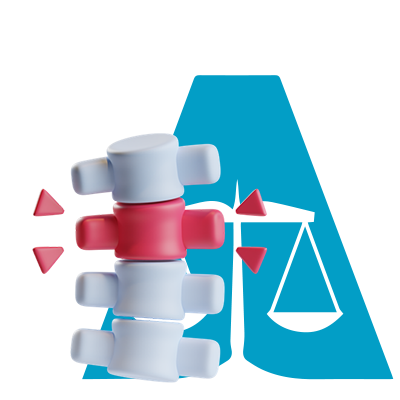Alberta Whiplash Injury Lawyers
Whiplash injuries are amongst the most common injuries we see, often resulting from vehicular accidents.
Schedule a free consultation to discuss your spinal cord injury case with an Assiff Law attorney today.
Our Whiplash Injury Attorneys fight for your rights after an accident.
Beyond the initial costs, whiplash injuries can lead to unforeseen complications down the line. We work closely with a trusted group of medical professionals who are experts at identifying potential long-term effects of your whiplash injury. This ensures that all aspects of your injury are considered when seeking compensation, making sure that you are covered in the long term.

Whiplash injuries can lead to significant medical expenses, loss of income, and even long-term care costs. It’s crucial to understand the full extent of these costs before accepting any insurance settlement.
An Assiff Law injury lawyer will work with medical experts to determine the full extent of your injuries and associated costs. We can negotiate with insurance companies and pursue legal action to get you the compensation you deserve.
Alberta Whiplash Injuries & Info
Whiplash injuries can have profound legal implications. These injuries can drastically affect your quality of life, from chronic pain to cognitive issues. Presenting a case in court requires a comprehensive understanding of the medical and legal aspects of whiplash. Recent statistics indicate a rise in whiplash-related claims in Alberta, emphasizing the importance of having experienced lawyers by your side.

Common causes of Whiplash Injuries
Whiplash injuries can result from various accidents, including:
Regardless of the cause, it’s important to seek medical attention immediately if you suspect a whiplash injury.
If you have been injured as a result of one of these accidents, contact an injury lawyer right away to ensure that you are aware and can account for the potential ramifications that your injury may present in the future.
Types of Spinal Cord Injuries
Whiplash injuries are medically classified based on their severity:
WAD I (Whiplash Associated Disorder I)
This is the mildest form of whiplash injury. Individuals with WAD I experience minor discomfort, often described as a slight ache or stiffness in the neck. Interestingly, there are no physical signs of injury, such as swelling or bruising, making it challenging to diagnose based solely on a physical examination. It’s essential to listen to the patient’s description of their symptoms and discomfort.
WAD II (Whiplash Associated Disorder II)
WAD II is characterized by noticeable neck pain accompanied by musculoskeletal signs. This means that there are clear physical indications of injury, such as muscle tenderness, swelling, or decreased range of motion in the neck. The pain can vary from moderate to severe and may limit the individual’s ability to turn their head or perform daily activities without discomfort.
WAD III (Whiplash Associated Disorder III)
Individuals with WAD III exhibit neurological signs, which are symptoms related to the nervous system. This can include decreased reflexes, numbness, or tingling in the arms or hands. The injury may have affected the nerve roots or spinal cord, leading to these neurological symptoms. It’s crucial to address these symptoms promptly as they indicate a more severe injury that could have long-term implications if not treated appropriately.
WAD IV (Whiplash Associated Disorder IV)
This is the most severe classification of whiplash injury. WAD IV involves a fracture or dislocation in the cervical spine. This type of injury is a medical emergency and requires immediate attention. The individual may experience intense pain, and there’s a risk of damage to the spinal cord, which could lead to paralysis or other serious complications. Diagnostic imaging, like X-rays or MRIs, is essential to determine the extent of the injury and guide treatment.
Each of these classifications helps medical professionals determine the best course of treatment and provides a framework for understanding the potential long-term implications of a whiplash injury.
Symptoms of Whipash Injuries
Understanding and recognizing the symptoms of whiplash is essential for seeking appropriate and timely medical attention. Here’s a deeper dive into the common symptoms:
Headaches
One of the most frequent complaints following a whiplash injury is headaches. These headaches often originate from the base of the skull and can radiate towards the forehead. The pain can vary from a dull ache to a sharp, throbbing sensation. The cause is often related to muscle tension or injury to the cervical vertebrae or soft tissues.
Neck Pain
Neck pain is a hallmark symptom of whiplash. Individuals may experience a range of discomfort, from a mild, nagging ache to severe, debilitating pain. The pain can be exacerbated by turning the head or maintaining a single position for extended periods. The injury to the muscles, ligaments, and tendons in the neck region often causes this pain.
Loss of Range of Motion
Following a whiplash injury, individuals might find it challenging to move their neck freely. They may struggle to turn their head side to side or nod up and down. This reduced mobility is often due to muscle stiffness, swelling, or damage to the cervical spine’s structures.
Numbness
A tingling or numb sensation in the arms, especially the fingers, can be alarming. This symptom indicates that there might be nerve involvement, possibly due to the nerve roots being compressed or irritated in the neck region. It’s essential to monitor this symptom closely, as it can provide insights into the injury’s severity.
Dizziness
Feeling lightheaded or unsteady is not uncommon after a whiplash injury. This dizziness can be due to changes in the neck’s proprioception, which affects our spatial awareness and balance. In some cases, injury to the inner ear structures or disturbances in blood flow can also contribute to this sensation.
If you or someone you know experiences these symptoms following an accident or sudden jolt to the head and neck, please consult a medical professional immediately. Early diagnosis and treatment can significantly impact recovery and prevent long-term complications.
Whipash Injury FAQ
What is Whiplash?
Whiplash is a common injury resulting from car accidents. It’s a soft tissue injury caused by the sudden “whipping” motion of the head during an impact. This injury can occur even in accidents at low speeds.
How can I recognize the symptoms of Whiplash?
Symptoms can appear immediately or take a few weeks to manifest. Common signs include headaches, blurry vision, nausea, dizziness, neck pain, loss of neck motion, numbness in the neck and shoulders, and sometimes cognitive or mood disturbances.
Can I get compensated for Whiplash in Alberta?
You can seek compensation for a whiplash-associated disorder with the help of a personal injury lawyer specializing in whiplash cases. Documenting all symptoms, treatments, and personal losses related to the injury is vital.
How is Whiplash treated?
The most common treatment is physical therapy, which can range from a few weeks to several years, depending on the injury’s severity. Rest is also crucial to allow the injured tissues to heal.
Do all Whiplash injuries fully heal?
Unfortunately, some people never fully recover from whiplash injuries, emphasizing the importance of seeking proper medical and legal advice.
Personal Injury Process
What Should I expect?
When you call Assiff Law injury lawyers, we immediately work on recovering compensation for your injuries.

Consult with an Edmonton Injury Lawyer
The first step is to speak with an experienced personal injury lawyer near you.
Our lawyers will review the details of your situation and your understanding of events — your side of the story — so we can determine whether there is any basis for a lawsuit. Then, once you’re ready to move forward, we’ll help you develop a strategy for pursuing compensation.
If we take your case, the process may look something like this:
Gather Evidence
A thorough investigation is the foundation of every case we take on. We use police reports, medical reports, and eyewitnesses’ statements to get to the bottom of things.
Send a Demand Letter
We’ll write a demand letter to the individual responsible for the accident, and their insurance company. We consider the entire financial impact of the situation, including provisions for future medical bills, lost wages, and other related costs.
File a personal injury lawsuit
When an insurance company refuses to offer an acceptable settlement, we gain leverage by filing a lawsuit on your behalf. In addition, filing a lawsuit will provide us access to additional information from the defendants that we otherwise wouldn’t have access to.
Discovery
After filing the suit, we can ask defendants for information that they might have been hesitant to provide. We can use these requests for admissions, interrogatories, and requests for production of documents to learn what evidence they have to support their claims.
Mediation
Once both parties have looked at the facts of the situation, we can schedule a mediation to help resolve the dispute. This gives us the chance to present our side of the story to the defendant’s attorney, and negotiate a fair resolution.
Settlement
If we’re able to reach an agreement prior to the start of the lawsuit, then we’ve reached a settlement. A settlement should take into account all past and future medical bills, lost wages, pain and suffering, etc., and will be paid out in one lump sum in return for you dropping the case.
Personal Injury Trial
If we are unable to settle for a fair amount, we go to trial. During the trial we present your case, employing the evidence we uncovered during discovery and present any expert testimony.
Appeal
What if the jury finds against you? If some sort of legal mistake was made by the defense team or the judge, we might choose to appeal. We would likely have to provide additional evidence and legal arguments in support of our position. If we were successful, the judge could overturn the previous ruling, or require another round of trials.
When you're hurting, We care.
We care. We understand, with our years of experience, what victims of accidents go through—from the obvious physical injuries to the impact they have on your day-to-day life, your job, your family and your overall well-being.
5.0
Awards & accolades.
The acknowledgement of our Edmonton personal injury lawyers have earned us multiple awards for the work we’ve done for thousands of clients. Best Lawyers, Canadian Lawyer Magazine and Consumers Choice have all awarded us for excellence in the field of personal injury law.
Free Consultation
Let's Get Started
We’re ready to fight for you. We’re ready to get you the justice you deserver. And we’re ready to start right now.